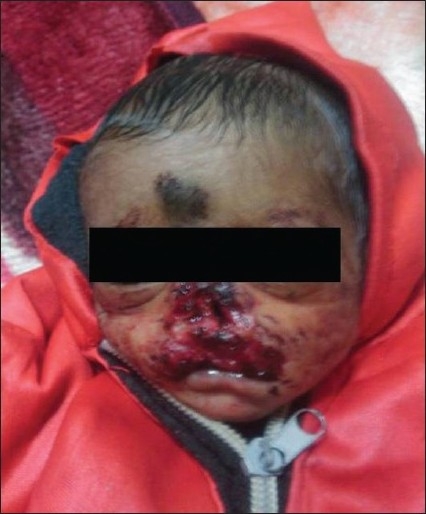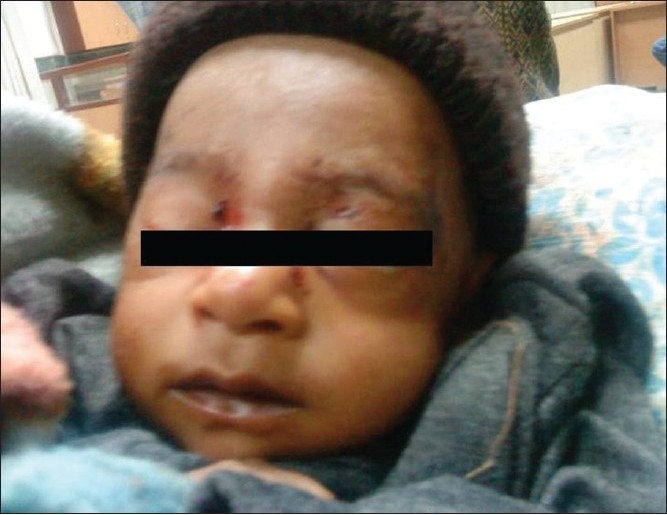Abstract
We present two cases of extreme neglect with injuries. These are perfect examples of gender bias. Our first case is a 20-day-old female neonate was brought to the pediatric emergency department with multiple rat bites to the face. A 9-month-old female infant was brought to the emergency care division with multiple rat bites on the eyes and upper extremities. These cases point towards the existing gender bias and extreme social neglect of females in the Indian society.
Keywords: Death, neonate, rat bite, trauma
INTRODUCTION
We present two cases of rat bites in urban population in the capital city of New Delhi, India. The cases point toward the existing gender bias and extreme social neglect of females in the Indian society.
CASE REPORTS
Case 1
A 20-day-old female neonate was brought to the pediatric emergency department with multiple rat bites to the face. The neonate, first in birth order was delivered by a midwife at home by a normal vaginal delivery at a gestation of 32 weeks, with a birth weight of 1.3 kg and was on breast feeds at home. The mother gave history that she went outside the home for some work, leaving behind the baby alone. On returning back at night she noted multiple rats biting the baby and brought the baby to the hospital. Father did not turn up in the hospital. The family lived near a wheat storage area.
On examination, the child was actively bleeding from the face, the nose and the lips. The entire nose and upper lip had been bitten off exposing both the nasal orifices [Figure 1]. The infant was in hypovolemic shock and was gasping. Cardiopulmonary and fluid resuscitation were initiated immediately but the child could not be revived despite all resuscitative efforts. Medicolegal proceeding was initiated by the police posted in the hospital and local police was informed.
Figure 1.

Multiple bites over the nose, both eyes and upper lip completely exposing both nostrils and completely eaten up upper lip
Case 2
A 9-month-old female infant was brought to the emergency care division with multiple rat bites on the eyes and upper extremities. The girl child was first in birth order with an uneventful birth history. The baby was left alone at home on floor, and the mother was working outside the house. Father was not available for interrogation. Mother spotted the baby at night with multiple bites on both the eyes and swollen nose; there was active bleeding from the nose [Figure 2]. The child was hemodynamically stable and was managed by intravenous fluids, antitetanus toxoid, anti rabies vaccine and ceftriaxone. The child is currently doing well under follow-up with pediatrics and plastic surgery departments. Medicolegal proceeding was initiated by the hospital police and the family was counseled by the medical social worker.
Figure 2.

Multiple bites over medial aspects of eyes, eyelids and nose. The nose is swollen with active bleeding
Rats are an example of urban pest that transmit disease by several mechanisms, directly by contaminating food with their urine or feces. Sometimes they transmit disease indirectly, as when fleas bite a disease infected rat, then a person or by biting people. Rat bites may cause local bacterial infection, which have good prognosis. Organisms recovered from bite wounds generally originate from the oral cavity of the biting animal, as well as from the patient's skin flora. Anerobes have been isolated from bite wound infections, especially those associated with abscess formation. Antibiotics such as cephalosporins or penicillinase-resistant penicillins are usually adequate for treatment of infectious complications of rat bites. Immunization against tetanus and rabies is also indicated, though rabies is rare after a rat bite. Wound management includes cleaning, debridement of tissue.
Rats have been associated with rat bite fever (by Streptobacillus moniliformes or Spirillum minus), haverhill fever, tetanus, multiple skin abscesses and rabies.[1,2] There is scarce information on medical literature on morbidity and mortality following rat bites in children. Isolated case reports have been described causing hypovolemic shock[1] or severe eyelid injury[3] or injury to the globe.[4] Death as a direct consequence of rat bites has been rarely reported in medical literature.[5]
Gender bias against girls in India, especially in the northern region is well documented.[6] Both infants reported were neglected girls, belonging to overcrowded areas with lower socioeconomic status. Young children in over crowded areas of lower socioeconomic status are known to be risk factor for the rat bites. Face and arms are the most frequently affected areas. The bites usually occur late at night, due to the nocturnal nature of the rodents. Urban deterioration, poverty, unemployment and rat infestations and bites are known to be associated.[2] The reports presented are examples of extreme social neglect of children and a rare cause of child trauma.
Footnotes
Source of Support: Nil.
Conflict of Interest: None declared.
REFERENCES
- 1.Donoso A, León J, Rojas G, Ramírez M, Oberpaur B. Hypovolaemic shock by rat bites.A paradigmatic case of social deprivation. Emerg Med J. 2004;21:640–1. doi: 10.1136/emj.2003.004911. [DOI] [PMC free article] [PubMed] [Google Scholar]
- 2.Hirschhorn RB, Hodge RR. Identification of risk factors in rat bite incidents involving humans. Pediatrics. 1999;104:e35. doi: 10.1542/peds.104.3.e35. [DOI] [PubMed] [Google Scholar]
- 3.Wykes WN. Rat bite injury to the eyelids in a 3-month-old child. Br J Ophthalmol. 1989;73:202–4. doi: 10.1136/bjo.73.3.202. [DOI] [PMC free article] [PubMed] [Google Scholar]
- 4.Myers CB, Christmann LM. Rat bite-an unusual cause of direct trauma to the globe. J Pediatr Ophthalmol Strabismus. 1991;28:356–8. doi: 10.3928/0191-3913-19911101-17. [DOI] [PubMed] [Google Scholar]
- 5.Yanai O, Goldin L, Hiss J. Fatal rat bites. (659, 658).Harefuah. 1999;136:611–3. [PubMed] [Google Scholar]
- 6.Saha A, Parmar V, Chawala D, Walia D. Gender bias in utilization of health services in Chandigarh. Indian J Pediatr. 2009;76:858. doi: 10.1007/s12098-009-0095-0. [DOI] [PubMed] [Google Scholar]


